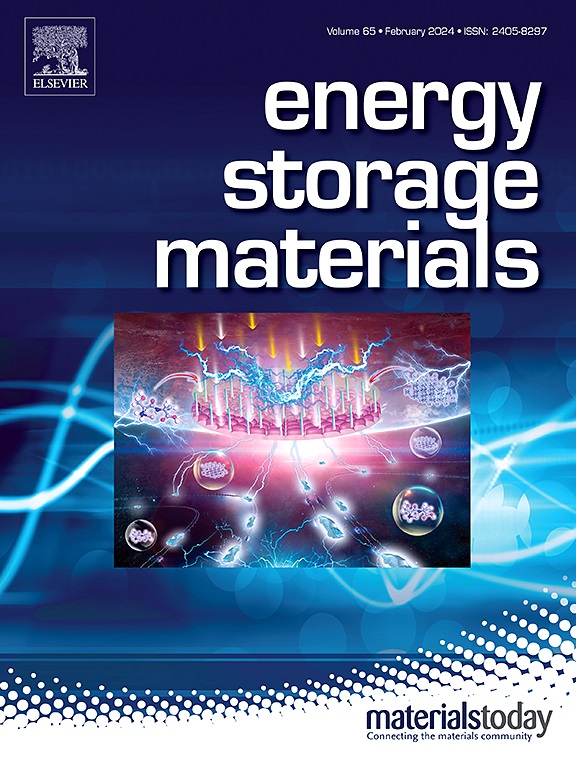Dry-processed ultra-high-energy cathodes (99.6wt%, 4.0 g cm−3) using single-crystalline Ni-rich oxides
IF 18.9
1区 材料科学
Q1 CHEMISTRY, PHYSICAL
引用次数: 0
Abstract
As the electric vehicle market rapidly expands as an eco-friendly means of transportation, there is a growing demand for innovative manufacturing processes that achieve high energy density while being environmentally sustainable and energy-efficient. To address these challenges, we developed a cathode using a solvent-free electrode process with single-crystalline LiNi0.8Co0.15Al0.05O2 (SC![]() NCA), renowned for its mechanical robustness and high specific capacity. This process involves conformal layers of carbon nanotubes (CNTs) on SC
NCA), renowned for its mechanical robustness and high specific capacity. This process involves conformal layers of carbon nanotubes (CNTs) on SC![]() NCA particles, resulting in superior Li+/electronic conductivity along with a cathode active-material ratio of 99.6 wt. %, electrode density of 4.0 g cm−3, and volumetric capacity of 835 mAh cm−3. Furthermore, the 3D digital twin analysis of the dry electrode elucidated the key features responsible for its outstanding electrochemical performance with remarkable clarity. This novel combination of CNT wrapping with solvent-free electrode processing not only increases the energy density but also improves the industrial feasibility of solvent-free electrodes for commercial LIBs application.
NCA particles, resulting in superior Li+/electronic conductivity along with a cathode active-material ratio of 99.6 wt. %, electrode density of 4.0 g cm−3, and volumetric capacity of 835 mAh cm−3. Furthermore, the 3D digital twin analysis of the dry electrode elucidated the key features responsible for its outstanding electrochemical performance with remarkable clarity. This novel combination of CNT wrapping with solvent-free electrode processing not only increases the energy density but also improves the industrial feasibility of solvent-free electrodes for commercial LIBs application.


干法加工的超高能阴极(99.6wt%, 4.0 g cm−3)使用单晶富镍氧化物
随着电动汽车作为一种环保交通工具的市场迅速扩大,对创新制造工艺的需求日益增长,既要实现高能量密度,又要实现环境可持续发展和节能。为了解决这些挑战,我们开发了一种阴极,采用无溶剂电极工艺,采用单晶LiNi0.8Co0.15Al0.05O2 (SC-NCA),以其机械坚固性和高比容量而闻名。该工艺涉及在SC-NCA颗粒上的碳纳米管(CNTs)共形层,从而获得优异的Li+/电子导电性,阴极活性材料比为99.6 wt.%,电极密度为4.0 g cm - 3,体积容量为835 mAh cm - 3。此外,对干电极的三维数字孪生分析非常清晰地阐明了其优异电化学性能的关键特征。这种碳纳米管包裹与无溶剂电极加工的新组合不仅增加了能量密度,而且提高了商业lib应用的无溶剂电极的工业可行性。
本文章由计算机程序翻译,如有差异,请以英文原文为准。
求助全文
约1分钟内获得全文
求助全文
来源期刊

Energy Storage Materials
Materials Science-General Materials Science
CiteScore
33.00
自引率
5.90%
发文量
652
审稿时长
27 days
期刊介绍:
Energy Storage Materials is a global interdisciplinary journal dedicated to sharing scientific and technological advancements in materials and devices for advanced energy storage and related energy conversion, such as in metal-O2 batteries. The journal features comprehensive research articles, including full papers and short communications, as well as authoritative feature articles and reviews by leading experts in the field.
Energy Storage Materials covers a wide range of topics, including the synthesis, fabrication, structure, properties, performance, and technological applications of energy storage materials. Additionally, the journal explores strategies, policies, and developments in the field of energy storage materials and devices for sustainable energy.
Published papers are selected based on their scientific and technological significance, their ability to provide valuable new knowledge, and their relevance to the international research community.
 求助内容:
求助内容: 应助结果提醒方式:
应助结果提醒方式:


